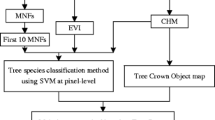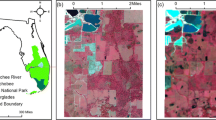Abstract
We evaluated the effectiveness of integrating discrete return light detection and ranging (LiDAR) data with high spatial resolution near-infrared digital imagery for object-based classification of land cover types and dominant tree species. In particular we adopted LiDAR ratio features based on pulse attributes that have not been used in past studies. Object-based classifications were performed first on land cover types, and subsequently on dominant tree species within the area classified as trees. In each classification stage, two different data combinations were examined: LiDAR data integrated with digital imagery or digital imagery only. We created basic image objects and calculated a number of spectral, textural, and LiDAR-based features for each image object. Decision tree analysis was performed and important features were investigated in each classification. In the land cover classification, the overall accuracy was improved to 0.975 when using the object-based method and integrating LiDAR data. The mean height value derived from the LiDAR data was effective in separating “trees” and “lawn” objects having different height. As for the tree species classification, the overall accuracy was also improved by object-based classification with LiDAR data although it remained up to 0.484 because spectral and textural signatures were similar among tree species. We revealed that the LiDAR ratio features associated with laser penetration proportion were important in the object-based classification as they can distinguish tree species having different canopy density. We concluded that integrating LiDAR data was effective in the object-based classifications of land cover and dominant tree species.










Similar content being viewed by others
References
Benz UC, Hofmann P, Willhauck G, Lingenfelder I, Heynen M (2004) Multi-resolution, object-oriented fuzzy analysis of remote sensing data for GIS-ready information. ISPRS J Photogramm Remote Sens 58:239–258
Brennan R, Webster TL (2006) Object-oriented land cover classification of lidar-derived surfaces. Can J Remote Sens 32:162–172
Carleer A, Wolff E (2004) Exploitation of very high resolution satellite data for tree species identification. Photogramm Eng Remote Sens 70:135–140
Carlson TN, Ripley DA (1997) On the relation between NDVI, fractional vegetation cover, and leaf area index. Remote Sens Environ 62:241–251
Chen JM, Cihlar J (1996) Retrieving leaf area index of boreal forests using Landsat TM images. Remote Sens Environ 55:153–162
Chubey MS, Franklin SE, Wulder MA (2006) Object-based analysis of Ikonos-2 imagery for extraction of forest inventory parameters. Photogramm Eng Remote Sens 72:383–394
Cleve C, Kelly M, Kearns FR, Moritz M (2008) Classification of the wildland-urban interface: a comparison of pixel- and object-based classifications using high-resolution aerial photography. Comput Environ Urban Syst 32:317–326
Cohen J (1960) A coefficient of agreement for nominal scales. Educ Psychol Meas 1:37–46
Definiens AG (2006a) Definiens professional-5 reference book. Definiens AG, Munich
Definiens AG (2006b) Definiens professional-5 user guide. Definiens AG, Munich
Ehlers M, Gahler M, Janowsky R (2003) Automated analysis of ultra high resolution remote sensing data for biotope type mapping: new possibilities and challenges. ISPRS J Photogramm Remote Sen 57:315–326
Ioki K, Imanishi J, Sasaki T, Morimoto Y, Kitada K (2010) Estimating stand volume in broad-leaved forest using discrete-return LiDAR: plot-based approach. Landsc Ecol Eng 6:29–36
Ke Y, Quackenbush LJ, Im J (2010) Synergistic use of QuickBird multispectral imagery and LIDAR data for object-based forest species classification. Remote Sens Environ 114:1141–1154
Laliberte AS, Rango A, Havstad KM, Paris JF, Beck RF, McNeely R, Gonzalez AL (2004) Object-oriented image analysis for mapping shrub encroachment from 1937 to 2003 in southern New Mexico. Remote Sens Environ 93:198–210
Laliberte AS, Fredrickson EL, Rango A (2007) Combining decision trees with hierarchical object-oriented image analysis for mapping arid rangelands. Photogramm Eng Remote Sens 73:197–207
Landis JR, Koch GG (1977) The measurement of observer agreement for categorical data. Biometrics 33:159–174
Makino T (1989) Revised Makino’s new illustrated flora of Japan. Hokuryukan, Tokyo (in Japanese)
Morimoto Y, Njoroge JB, Nakamura A, Sasaki T, Chihara Y (2006) Role of the EXPO’70 forest project in forest restoration in urban areas. Landsc Ecol Eng 2:119–127
Pal M, Mather PM (2003) An assessment of the effectiveness of decision tree methods for land cover classification. Remote Sens Environ 86:554–565
Pascual C, Garcia-Abril A, Garcia-Montero LG, Martin-Fernandez S, Cohen WB (2008) Object-based semi-automatic approach for forest structure characterization using lidar data in heterogeneous pinus sylvestris stands. For Ecol Manag 255:3677–3685
R Development Core Team (2009) R: a language and environment for statistical computing. R Foundation for Statistical Computing, Vienna, Austria. ISBN 3-900051-07-0. http://www.R-project.org
Sasaki T, Morimoto Y, Imanishi J (2007) The stand structure and soil properties of the forested area in a large scale reclamation site for 30 years after construction. J Jpn Inst Landsc Arch 70(5):413–418 (in Japanese with English abstract)
Sasaki T, Imanishi J, Ioki K, Morimoto Y, Kitada K (2008) Estimation of leaf area index and canopy openness in broad-leaved forest using airborne laser scanner in comparison with high-resolution near-infrared digital photography. Landsc Ecol Eng 4:47–55
Satake Y, Hara H, Watari S, Tominari T (1989) Wild flowers of Japan: woody plants I and II, 1st edn. Heibonsha, Tokyo (in Japanese)
Walker JS, Blaschke T (2008) Object-based land-cover classification for the Phoenix metropolitan area: optimization vs. transportability. Int J Remote Sens 29:2021–2040
Wulder MA, Hall RJ, Coops NC, Franklin SE (2004) High spatial resolution remotely sensed data for ecosystem characterization. Bioscience 54:511–521
Yu Q, Gong P, Clinton N, Biging G, Kelly M, Schirokauer D (2006) Object-based detailed vegetation classification with airborne high spatial resolution remote sensing imagery. Photogramm Eng Remote Sens 72:799–811
Acknowledgments
We wish to acknowledge the staff of the Commemorative Organization for the Japan World Exposition ’70 for their support in the field observation.
Author information
Authors and Affiliations
Corresponding author
Electronic supplementary material
Below is the link to the electronic supplementary material.
Rights and permissions
About this article
Cite this article
Sasaki, T., Imanishi, J., Ioki, K. et al. Object-based classification of land cover and tree species by integrating airborne LiDAR and high spatial resolution imagery data. Landscape Ecol Eng 8, 157–171 (2012). https://doi.org/10.1007/s11355-011-0158-z
Received:
Revised:
Accepted:
Published:
Issue Date:
DOI: https://doi.org/10.1007/s11355-011-0158-z




